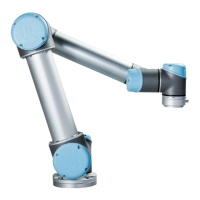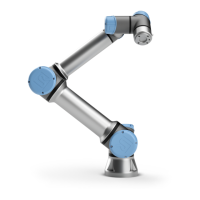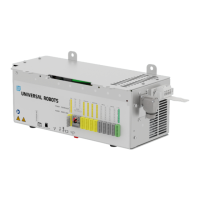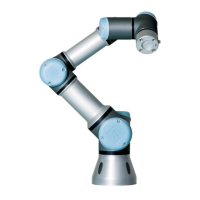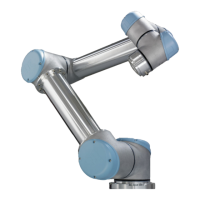14.4 Command: Move
are the maximum joint speed and joint acceleration, specified in deg/s and deg/s
2
, respec-
tively. If it is desired to have the robot arm move fast between waypoints, disregarding the
path of the tool between those waypoints, this movement type is the preferable choice.
• moveL moves the Tool Center Point (TCP) linearly between waypoints. This means that
each joint performs a more complicated motion to keep the tool on a straight line path. The
shared parameters that can be set for this movement type are the desired tool speed and
tool acceleration specified in mm/s and mm/s
2
, respectively, and also a feature.
• moveP moves the tool linearly with constant speed with circular blends, and is intended
for some process operations, like gluing or dispensing. The size of the blend radius is by
default a shared value between all the waypoints. A smaller value will make the path
turn sharper whereas a higher value will make the path smoother. While the robot arm is
moving through the waypoints with constant speed, the robot control box cannot wait for
either an I/O operation or an operator action. Doing so might stop the robot arm’s motion,
or cause a protective stop.
• Circle move can be added to a moveP to make a circular movement. The robot starts the
movement from its current position or start point, moves through a ViaPoint specified on
the circular arc, and an EndPoint that completes the circular movement.
A mode is used to calculate tool orientation, through the circular arc. The mode can be:
– Fixed: only the start point is used to define tool orientation
– Unconstrained: the start point transforms to the EndPoint to define tool orientation
Shared parameters
The shared parameters in the bottom right corner of the Move screen apply to the movement
from the previous position of the robot arm to the first waypoint under the command, and from
there to each of the following waypoints. The Move command settings do not apply to the path
going from the last waypoint under that Move command.
e-Series II-70 Version 3.11
Copyright © 2009–2019 by Universal Robots A/S. All rights reserved.
